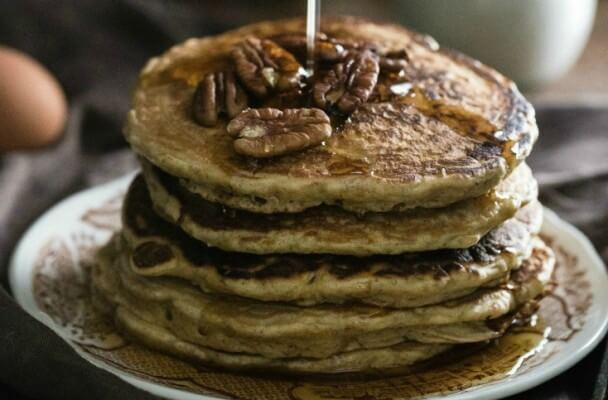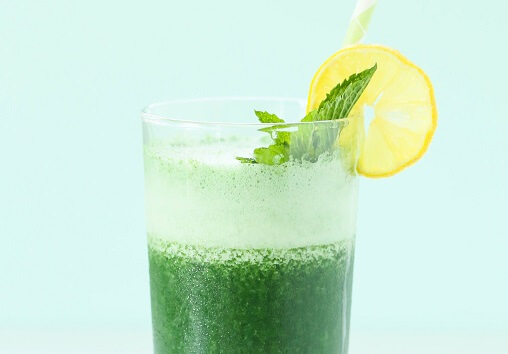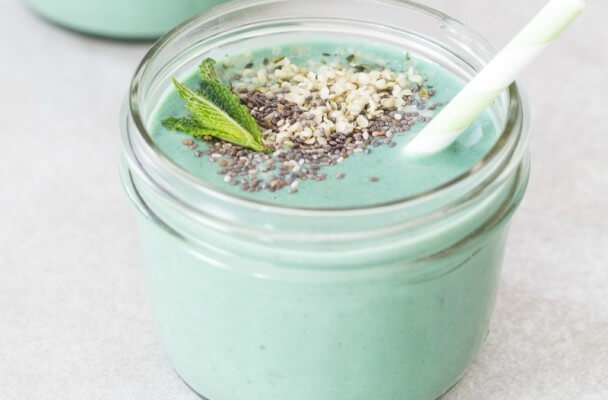High Blood Pressure & Your Diet
One in four Americans have hypertension, according to the 2012 National Health Interview Survey (Blackwell et al., 2014). Hypertension is a significant risk factor for cardiovascular disease. It can be modified by the foods you eat, making it important for those with the condition to follow a high blood pressure diet.
How Blood Pressure Is Measured
A blood pressure measurement is just what it sounds like: it is the amount of physical force the blood exerts upon vessel walls. The circulatory system is responsible for ensuring that blood travels down to the tips of the toes and still has enough force to return to the heart. Thus, the heart must be able to exert enough pressure to keep blood flowing the correct direction.
A blood pressure measurement consists of two parts: systolic and diastolic pressure (American Heart Association 2015). Systolic blood pressure, the upper number in your blood pressure reading, is the amount of force your heart exerts when it beats. Diastolic blood pressure, the bottom number, is the pressure in the arteries as the heart refills with blood as it prepares to beat again. Systolic pressure is always higher than diastolic pressure.
What Is High Blood Pressure?
It is healthiest to keep blood pressure below 120/80 mm Hg (millimeters of mercury, the unit of measurement for blood pressure). People with systolic pressure between 120-139 or diastolic pressure between 80-89 are considered to be in the “prehypertension” range. Stage 1 hypertension, the lowest level of high blood pressure, is a systolic pressure of 140-159 or a diastolic pressure of 90-99. People with Stage 2 hypertension have a systolic pressure higher than 160 and a diastolic measurement higher than 100. When the blood pressure tops 180/110, a person is considered to be in hypertensive crisis and requires immediate medical attention. It is also important to note that these ranges are for healthy people without any serious illness (National Heart, Blood, and Lung Institute, 2015).
Hypertension Increases Risk of Cardiovascular Disease
Hypertension reflects an increased burden placed upon the heart. Even people in the prehypertension range have an elevated risk of cardiovascular disease. For example, a landmark study found that women with blood pressure in the prehypertensive range had a risk of cardiovascular disease 2.5 times higher than that of a women with normal blood pressure. Similarly, men in the prehypertensive range had a 1.6 times higher risk than men with blood pressure in a normal range (Ramachandran et al., 2001). Risk increases even more dramatically with the onset of Stage 1 hypertension or higher. This places individuals at increased risk for heart failure, myocardial infarction, stroke, and peripheral artery disease.
Dietary Factors to Reduce Hypertension
The foods you eat have a major impact on hypertension. In particular, consuming too much salt significantly elevates your risk of high blood pressure (Blood Pressure UK, 2008). The kidneys take signals from the amount of salt in the body to determine whether to retain water or excrete it. At higher levels of salt intake, the kidneys decide to retain water to balance your electrolyte levels. This increases the pressure placed on blood vessels.
One way to reduce risk of hypertension is to dramatically limit the salt you eat. Reducing your reliance on table salt is a good start. However, it is also important to take note of sodium levels in the foods you eat. Processed foods, particularly processed meats, tend to be very high in salt. Even innocuous foods such as condiments can pack a large punch when it comes to salt intake. For the optimal high blood pressure diet, try to keep your sodium intake below 1,500 mg per day (American Heart Association, 2016).
On the other hand, ensuring your diet contains enough potassium and calcium can help alleviate hypertension. These nutrients set off a cascade of events that reduce water retention and increase the levels of important hormones that lower blood pressure (McCarron & Reusser, 1999).
Preventing restriction of the diameter of blood vessels permits greater blood flow and, therefore, is another great way to reduce blood pressure. This is possible by reducing levels of “bad” LDL cholesterol, which forms sticky plaques that inhibit blood flow and cause blood pressure to spike. A diet rich in fiber and low in saturated fat improves cholesterol levels.
In fact, the National Heart, Lung, and Blood Institute created a high blood pressure diet plan specially formulated to target hypertension. Called the DASH diet, this plan is low in salt and saturated fat but high in potassium, calcium, and fiber. The DASH diet emphasizes eating fresh fruits and vegetables, which are rich in fiber and potassium. In particular, bananas, avocados, potatoes, and dark leafy green vegetables are good sources of potassium.
For protein, the DASH diet encourages adherents to eat red meat sparingly. Lean turkey, chicken, or fish are good sources of protein. Eating non-animal proteins such as nuts and seeds also reduces saturated fat intake while providing heart-healthy omega-3 fatty acids.
Healthy Recipes to Help Lower Blood Pressure
Dishes that are low in sodium and saturated fat are a great starting point for those seeking to regulate their blood pressure; but, a rich reserve of calcium and potassium give these recipes apart with additional benefits for those afflicted with hypertension.

Quinoa Pancakes Recipe
Start your day off right with a healthy pancake platter! These flavorful flapjacks offer a familiar breakfast plate that has been modified to meet your needs. Each serving supplies modest amounts of potassium and calcium with less than 2% of the Daily Value (DV) for sodium and less than a gram of saturated fat! Be sure to skip the syrup or to opt for a sugar-free variety.
Ingredients: Quinoa, whole wheat pastry flour (or brown rice flour for gluten-free cakes), eggs, milk, maple syrup or honey, raw pecans, baking powder, vanilla extract, salt.
Total Time: 15 minutes
| Yield: 7 pancakes

Spirulina Smoothie Recipe
Enjoy a refreshing smoothie that supplies the nutritive value of a superfood in an easy-to-prepare and palpably palatable blended beverage. This spirulina smoothie combines the tart taste of lemon with the sweet savor of apple juice to perfectly complement the unique flavor profile of the antioxidant-rich algae.
Ingredients: Spirulina, banana, fresh spinach, apple juice, crushed ice, lemon juice.
Total Time: 2 minutes
| Yield: 2 smoothies

Protein-Packed Detox Smoothie Recipe {vegan}
Another liquid means of managing blood pressure, this protein-packed smoothie supplies a superb source of the nutrients you need without the surplus of saturated fats or sodium. Specifically, the drink delves out a whopping 71% of the DV for calcium and a stellar 20% of the DV for potassium with only 212 mg of sodium and less than 1.5 grams of saturated fat.
Ingredients: Almond milk, frozen banana, spirulina, hemp protein powder (optional), fresh mint, chia seeds, hemp hearts.
Total Time: 5 minutes
| Yield: 2 servings

Kale Quinoa Salad Recipe
This superb salad is a delicious dish for lunch or dinner that dishes out plenty of potassium and calcium to keep your hypertension at bay. A wide range of other nutrients, including vitamin A, vitamin C, iron, fiber and protein, are also included to ensure that your good health doesn’t just end at a stable blood pressure, but extends even further to help meet all your nutritional needs.
Ingredients: Quinoa, fresh baby kale, purple cabbage, carrots, fresh dill, boiled eggs, rice wine, extra virgin olive oil, black pepper.
Total Time: 25 minutes
| Yield: 8 servings
Snacks to Help Lower Blood Pressure
It’s tough to keep your motor running throughout the work day without overindulging. Get much-needed energy without sending your blood pressure levels through the roof with the snacks on our How to Lower Blood Pressure article and find even more tips, snacks and recipes on our DASH diet page.
Healthy Eating
- Healthy Snacks
- Healthy Highlights
- 5 Uses for Cacao Powder
- 5 Ways to Eat Farro
- 6 Best Gluten-Free Foods
- Alcohol and the Body
- Almond Flour Recipes
- Anti-Aging Superfoods
- Beat the Afternoon Slump
- Benefits of a Plant-Based Diet
- Benefits of Baobab
- Benefits of Cashews
- Benefits of Coconut Oil for Hair
- Benefits of Coconuts
- Benefits of Dates
- Benefits of Fenugreek
- Benefits of Garcinia Cambogia
- Benefits of Goji Berries
- Benefits of Kale Chips
- Benefits of Monk Fruit Sweetener
- Benefits of Peanuts
- Benefits of Pecans
- Benefits of Pistachios
- Benefits of Pumpkin Seeds
- Benefits of Spelt Flour
- Benefits of Steel Cut Oats
- Benefits of Sunflower Seeds
- Benefits of Tiger Nuts
- Benefits of Turmeric
- Benefits of Walnuts
- Benefits of Wheatgrass
- Best Food Fads
- Cacao vs Cocoa
- Caffeine-Free Energy Foods
- Chocolate That's Good for You
- Diet vs. Exercise
- Fat Burning Foods
- Food Myths Debunked
- Foods for Bone Density
- Foods for Colon Health
- Foods for Healthy Hair
- Foods for Healthy Skin
- Foods to Help Sleep
- Foods to Reduce Stress
- Green Tea Benefits
- Healthy Baking Flours
- Heart Healthy Habits
- High Protein Health Risks
- How to Boost Your Metabolism
- How to Lose Weight While Aging
- How to Throw a Vegan BBQ
- Kaniwa vs Quinoa
- Little Health Foods
- Low-Carb: Fad or Friend?
- Making Healthier Desserts
- Mediterranean Diet Meal Plan
- Natural Beauty Products
- Nuts for Weight Loss
- Preparing Vegan Meals
- Preventing Muscle Degeneration
- Rare Superfoods
- Reduce Sugar Intake
- Save Time By Going Vegan
- Smarter Snack Swaps
- Smoothie Ingredients
- Soy Protein vs Whey Protein
- Starting a Plant-Based Diet
- Steel Cut vs Rolled Oats
- Sugar Substitutes
- Vegan Proteins
- Vegan Substitutions for Fall Recipes
- Why Go Vegan
- Healthy Meals
- Healthy Recipes
- Sports Nutrition
- Vitamins, Minerals & Nutrients
